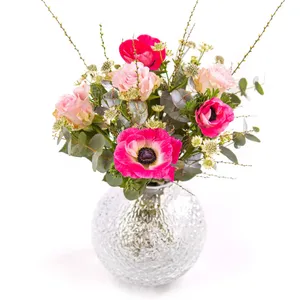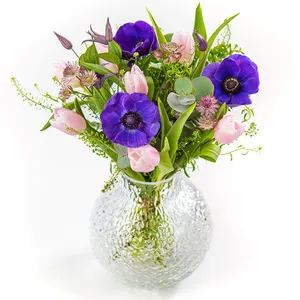Anemones: The Graceful and Whimsical Bloom
Anemones are delicate, eye-catching flowers with silky petals and a striking dark centre, known for their whimsical charm and bold contrast. They symbolise anticipation, protection, and forsaken love, making them a flower rich in meaning. Available in vibrant shades of red, pink, purple, white, and blue, anemones add elegance and movement to any floral arrangement. Their simple yet dramatic appearance makes them a favourite for romantic and modern designs alike.
COMMON NAME
Anemone
BOTANICAL NAME
Anemone coronaria
ORIGIN
Mediterranean region
PEOPLE ALSO CALL IT
Windflower
FLOWERING TIME
Spring to early summer, also winter in mild climates
ASPECT
Full sun to partial shade
SYMBOLISM
Anticipation, protection, forsaken love, fragility
Care Tips for a Cut Anemones in a Vase
Trim Stems at an Angle: Re-cut the stems at a diagonal before placing them in water to improve hydration.
Condition the Blooms: Allow the flowers to hydrate in fresh water for at least two hours before arranging them.
Use Fresh Water and Change Regularly: Replace the water every two days to prevent bacteria growth and keep the flowers fresh.
Support the Stems: Anemone stems can be delicate and may need extra support from a vase or floral grid.
Keep in a Cool Spot: Avoid direct sunlight and excessive heat to prolong the life of the blooms, as they are sensitive to warm temperatures.
Symbolism & Meaning
Anemones carry a wealth of symbolism, often representing anticipation due to their delicate blooms that open and close with sunlight. They are also associated with protection, stemming from ancient myths where anemones were thought to ward off evil. In some cultures, they symbolize forsaken or fragile love, making them a poignant choice for reflective or romantic occasions. Their name, derived from the Greek word for wind, emphasizes their fleeting and delicate nature.
Types of Anemones
Anemones come in various species, offering diversity in appearance and use. Anemone coronaria, also known as the poppy anemone, is the most popular for floral arrangements, with vibrant, single-layered petals and a striking dark centre. Japanese Anemones (Anemone hupehensis) are perennial varieties that bloom in late summer and fall, adding beauty to gardens. Wood Anemones (Anemone nemorosa) are wildflowers with smaller, delicate blooms and are often found in woodland settings.
Frequently Asked Questions About Anemones
Anemones can be planted in either autumn or early spring, depending on the desired bloom time and your climate. For the best results:
- In mild climates, plant in autumn to allow the tubers to establish before winter for spring blooms.
- In colder climates, plant in early spring after the danger of frost has passed for summer blooms.
- Before planting, soak the tubers in water for 3-4 hours to promote quicker germination.
Anemones are graceful flowers with a wide range of colours, including white, pink, purple, red, and blue. They have delicate, cup-shaped blooms with a dark, central eye surrounded by contrasting thin petals. The flowers typically grow on slender stems above finely divided, fern-like foliage, making them a popular choice for delicate, breezy floral arrangements.
The flowering time depends on the variety and planting season.
- Spring-Flowering Anemones: Such as Anemone blanda and Anemone coronaria, bloom from March to May.
- Summer to Early Autumn Varieties: Japanese anemones (Anemone hupehensis) and others bloom from July to September, adding vibrant colours to late-season gardens.

